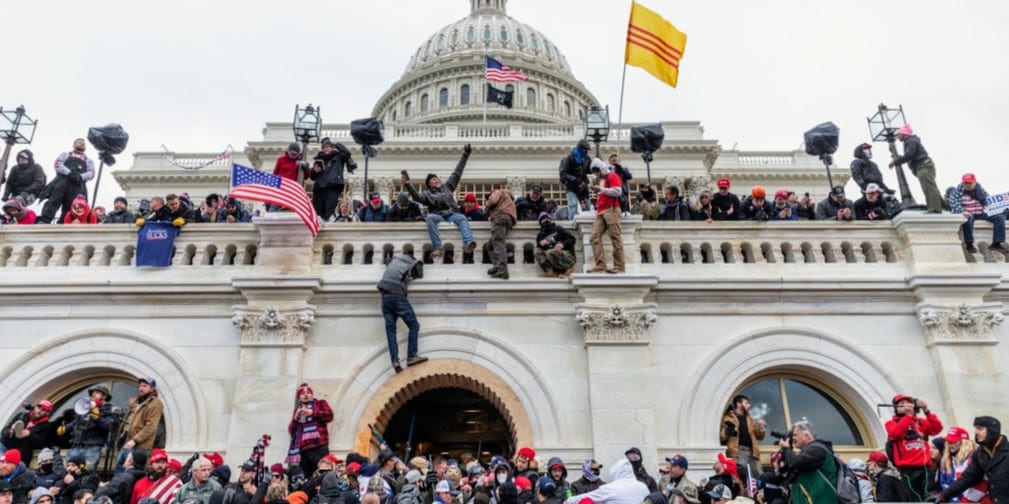Report Reveals Facebook Provided Warning to FBI Before January 6
Justin Hendrix / May 5, 2022
This piece is cross published at Just Security.
A new report from the U.S. Government Accountability Office (GAO) reveals that seven federal law enforcement and intelligence agencies were aware of open source information on social media about “potential violence” planned for January 6, 2021. The report suggests that federal agencies had ample authority and information to anticipate and prepare for a violent assault on the Capitol.
The findings of the report, titled “Federal Agencies’ Use of Open Source Data and Related Threat Products Prior to January 6, 2021,” also raise questions about statements by FBI Director Christopher Wray in previous testimony to Congress. The report states that the representatives of at least two social media platforms – Facebook and Parler – told the GAO that their companies provided information to the FBI “regarding potential violence at the U.S. Capitol on January 6.”
With the House Select Committee investigating the January 6 attack set to kick off public hearings next month, the report may inform several lines of inquiry. Those include the failure of law enforcement and intelligence agencies to take action on the threat, what legal authorizations are already in place for social media surveillance, how those authorities are used in practice, and what technical tools and resources federal agencies need to do their jobs. Looming over all of these questions is a broader set of concerns about civil liberties, and what some regard as bias in the way the federal government failed to act on the threat of violence from former President Donald Trump’s supporters.
What the GAO report says
The May 2022 GAO report is a “a public version of a sensitive report” issued on Feb. 16, 2022 and accordingly omits some information that federal agencies considered sensitive. Prepared for congressional leadership, the report is intended to “review the extent to which information sharing and coordination related to the Capitol attack occurred on or before January 6, 2021.”
GAO looked specifically at what open source data was obtained from social media by federal agencies and what analytical reports, or “threat products,” the agencies produced with that data. It scrutinized agencies collecting and handling such information including the FBI, the Department of Homeland Security (DHS) Office of Intelligence and Analysis, U.S. Secret Service, U.S. Park Police, National Park Service, Architect of the Capitol, U.S. Capitol Police, House Sergeant at Arms, Senate Sergeant at Arms, and the U.S. Postal Inspection Service.
The GAO also “interviewed representatives from three social media platforms, including two large ones—Facebook and Twitter—and a smaller one—Parler—to determine the extent to which they shared open source information with federal agencies.” While Parler previously revealed to congressional investigators that it sent specific warnings to the FBI about threats on its platform, including threats to kill politicians and the coordination of armed groups, the GAO report is the first to confirm that Facebook shared information with the FBI regarding potential violence at the U.S. Capitol on January 6:
Page 14: "According to two of the three social media platforms included in our review, they provided information to one of the 10 federal agencies related to potential violence prior to January 6. Specifically, Facebook and Parler representatives indicated that the platforms shared information with a federal agency regarding potential violence at the U.S. Capitol on January 6. For example, on December 24, 2020, Parler emailed information on a user posting threats to kill politicians and to coordinate armed forces of individuals on January 6."
Page 17: "According to FBI officials, the FBI reviewed social media posts, dated November 3, 2020, through January 5, 2021. FBI officials noted that its review of these posts did not reveal information specifically citing the 'U.S. Capitol' during this review period. The review did, however, reveal one post related to potential violence in Washington, D.C., on January 6, 2021. In addition, Facebook officials noted that they shared information with the FBI before, during, and after January 6. For example, officials from the platform noted that they were in regular contact with the FBI and the Metropolitan Police Department during the events of January 6— providing information on multiple individuals during the attack on the Capitol. Officials from Twitter stated that they were in ongoing contact with the FBI and DHS on January 5, 2021, to share information relating to the election. However, Twitter officials stated that the platform did not share information with federal agencies related to January 6."
While the GAO report initially refers vaguely to “a federal agency” as the recipient of information “regarding potential violence at the U.S. Capitol on January 6,” Parler’s letter was sent specifically to the FBI, the FBI is the only federal agency listed in a table as having “received data from social media platforms” directly, and the GAO goes on to say “Facebook officials noted that they shared information with the FBI before, during, and after January 6.”
There is a potential discrepancy between what Facebook and Parler told GAO about the information they gave the FBI, and what the FBI told the GAO. The report states that “according to FBI officials, the FBI reviewed social media posts, dated November 3, 2020, through January 5, 2021. FBI officials noted that its review of these posts did not reveal information specifically citing the ‘U.S. Capitol’ during this review period.” It is also puzzling that the FBI would come across no such references given that social media was replete with such content and other federal agencies collected and analyzed it (see also the bipartisan Senate report on such findings).
The report notes that while 10 federal agencies “obtained open source data on the events of January 6 by conducting web searches,” seven agencies– including the FBI, DHS Office of Intelligence and Analysis, U.S. Park Police, Architect of the Capitol, U.S. Capitol Police, House Sergeant at Arms, and U.S. Postal Inspection Service– “obtained open source data in advance on the potential for violence on January 6.”
The report also says all ten federal agencies received open source data from local and state agencies, including the Metropolitan Police Department, D.C. Fusion Center, and the Northern Virginia Regional Intelligence Center. With regard to analysis of the collected data, the report indicates that federal agencies generated 38 threat products, with 26 “focused on events planned for January 6” specifically. The FBI’s threat product,- the Norfolk report, indicated the possibility that extremist groups may commit violent acts and that groups might attack the Capitol or Congress.
What the FBI Director previously said
The GAO report raises questions about statements made by FBI Director Christopher Wray to Congress concerning the role of open source intelligence from social media and his agency’s handling of January 6.
At a House Judiciary Committee hearing on June 10, 2021, when Wray was directly asked whether the FBI received any tips about threats to the Capitol from social media platforms, the Director equivocated in his response:
Rep. Swalwell: "Prior to January 6th did the FBI receive any tips from social media companies about threats to the Capitol?"
Director Wray: “Well we’ve had so much information now I’m reluctant to sort of answer any question about the word ‘any,’ especially because we’re now 500 arrests into the investigation after the fact. Certainly we were aware of online chatter about the potential for violence, but I’m not aware that we had any intelligence indicating that hundreds of individuals were going to storm the Capitol itself, to my knowledge.”
However, during a hearing of the House Oversight Committee the following week, Chairwoman Caroline Maloney (D-NY) revealed that Parler had shared over 50 tips with the FBI warning of violence in advance of January 6, including one post, for example, that stated “don’t be surprised if we take the #capital building.” Now, the GAO report adds that Facebook says it also sent the FBI information regarding potential violence at the Capitol on January 6.
Another issue raised by the GAO report is whether existing authorities allowed for the FBI to scan social media for threats of violence in advance of January 6. At the same House Oversight hearing, Rep. Alexandria Ocasio-Cortez (D-NY) asked Wray whether the FBI typically incorporates insights from social media into its investigation of violent extremism. Wray suggested his hands were tied. “What we can’t do on social media is, without proper predication and an authorized purpose, is just monitor ‘just in case’ on social media,” he said. “Now if the policies should be changed to reflect that — that might be one of the important lessons learned coming out of this whole experience. But that’s not something that currently the FBI has either the authority or certainly the resources frankly to do.”
While the GAO report does describe a thicket of regulations and procedures, it is clear that the FBI already has wide latitude to monitor social media for potential threats. In accordance with the attorney general’s guidelines, in preparation for highly sensitive events (such as the certification of the presidential election), the FBI can engage in “proactively surfing the Internet to find publicly accessible websites and services.”
What’s more, the GAO report also indicates the FBI’s hands were not tied. The report states that the FBI “used open source analysis tools to perform web searches of social media platforms prior to January 6” and “obtained information from those tools about potential violence at the U.S. Capitol prior to January 6.”
The FBI did not respond to requests for comment for this article.
Other questions raised by the GAO report
The GAO report puts a spotlight on other questions that may be considered by the House Select Committee investigating January 6 and by other congressional committees. The Select Committee is mandated to examine the “activities of intelligence agencies, law enforcement agencies, and the Armed Forces, including with respect to intelligence collection, analysis, and dissemination and information sharing among the branches and other instrumentalities of government.”
One question is about what new technical capabilities and other resources to monitor social media federal agencies may have acquired in the wake of January 6, or may seek to acquire in the future. Wray has referred to the analytic problem of parsing the high volume of social media information — separating the noise from the real threat. The FBI and DHS have both invested in contracts with social media analytics and tracking tools since January 6. This year, the FBI entered into a new contract for a tool called Babel X that will permit agents to monitor a variety of social media sites, according to the Washington Post.
The contracting documents suggest the FBI is also interested in “predictive analytics” that might “point toward possible actions of a subject or group,” an idea that has raised eyebrows among experts concerned with civil liberties and with the underlying technologies. The GAO report would appear to suggest that before January 6 federal agencies had the information on hand with their existing tools, and that in any case some social media companies provided relevant information directly to the Bureau.
The Committee will also have to grapple with the broader question as to why the federal intelligence apparatus – reorganized after the attacks of September 11th, 2001 to ensure that information about looming threats is widely shared within the relevant agencies – failed to prevent the attack on the Capitol even with substantial production of raw intelligence and analytical “threat products” indicating the specific prospect of violence on January 6.
Authors

